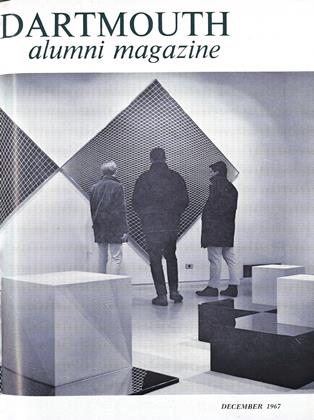By Robert E. Keeton and Jeffrey O'Connell '51. Homewood, Ill.: Dow Jones-Ir-win, Inc., 1967. 145 pp. $4.95.
Jeff O'Connell's extraordinary energy has carried him beyond the field of automobile safety, where the results of his findings were highly influential in the passage of the new safety legislation, into a critical study of modern automobile insurance coverage. The test of criticism is whether a better answer can be found and the authors have done just that in the form of an exciting new automobile insurance plan called Basic Protection. This little book is so well-organized that it reminds one of a well-researched trial transcript. The proper questions are asked which in turn elicit the correct responses as the attorney anticipates and counters the opposition's every move.
To appreciate this new plan one must understand, at least generally, some of the weaknesses of negligence liability insurance as it exists today. To collect under this form of insurance the insured must make his claim against the other driver's insurance company and prove that the accident was the other driver's fault. Therefore, payments are uncertain because without such proof there is no recovery, although expenses and wage loss have been incurred. Even if recovery is forthcoming, it usually is awarded (if litigation is involved) years after the accident, owing to overcrowded court dockets. The award is given in one lump sum with no advances to cover expenses as they occur. This puts the injured party at a disadvantage and often forces him to settle with the insurance company at a loss to himself. In ad- dition, settlement of these cases normally requires an attorney at added expense (one-third of the award if the case is taken on a contingent fee basis). Finally, there is no provision for physical rehabilitation. As a matter of fact, liability insurance works against rehabilitation because this would lessen the chances for a large damage recovery at trial. To make matters worse, negligence liability insurance is inherently wasteful because it duplicates payments and buys off slightly hurt victims for nuisance value. As the authors state ". . . less than half of the amount paid in automobile liability insurance premiums ever goes to injured persons."
It is obvious that a new form of insurance coverage is needed and O'Connell and Keeton have come up with it in the form of Basic Protection (BP). Under BP the insured no longer has to prove that the other driver is at fault, or that he is free from it, but rather recovery is guaranteed to the insured from his own insurance company for almost all types of out-of-pocket expenses, including medical, and wage loss up to $10,000. The guaranteed payments are made every month directly to the insured so that he can meet his living and accident expenses as they occur.
What about losses over $10,000? BP has dual claim potential. An injured party under BP will receive payments up to $10,000 regardless of fault. If there is negligence involved on the part of the other driver, the insured can bring suit for such losses, but he can only be paid under the negligence claim for losses over $10,000
Premiums for BP will be 15-25% cheaper than those of negligence liability insurance for several reasons: (1) Reimbursement is limited to net loss with no overlapping; (2) There is a deductible provision; (3) No recovery for property damage (because of existing collision insurance), and (4) BP will be compulsory.
What are the chances for passage of BP in the state legislatures? Bills to enact it have been filed in Michigan, Massachusetts, and New York. Wide-scale public support is necessary to counter the opposition of the trial bar and some insurance companies. It is hoped that this brief review will do its small part in exposing BP to the general public. Its passage is long overdue.
A Government major, Mr. Slive attendedthe University of Virginia Law School andreceived the E. Barrett Prettyman Fellowship in Trial Advocacy from the Ford Foundation. He is now assistant to the Directorof Financial Aid, Dartmouth College.
 View Full Issue
View Full Issue
More From This Issue
-
 Feature
FeatureFood for Alumni Thought
December 1967 -
 Feature
FeatureThe Dartmouth-Talladega Alliance
December 1967 By WILLIAM R. MEYER -
 Article
ArticleWith the Big Green Teams
December 1967 -
 Article
ArticleThe Undergraduate Chair
December 1967 By JOHN BURNS '68 -
 Class Notes
Class Notes1923
December 1967 By WALTER C. DODGE, DR. THEODORE R. MINER, TRUMAN T. METZEL -
 Class Notes
Class Notes1941
December 1967 By EARL H. COTTON, LOUIS A. YOUNG JR.
MICHAEL L. SLIVE '62
Books
-
 Books
Books"The Technology of New York State Timbers"
APRIL, 1927 -
 Books
BooksEINSTEIN: A PICTORIAL BIOGRAPHY.
June 1956 By CLIFFORD L. JORDAN '45 -
 Books
BooksNEUROLOGY of the OCULAR MUSCLES
May 1948 By Hanford L. Auten '32. -
 Books
BooksAMOS, THE BEAGLE WITH A PLAN.
May 1953 By Margaret W. Minnes -
 Books
BooksNO BUGLES FOR SPIES.
JULY 1963 By MICHAEL CHOUKAS '27 -
 Books
BooksTHE NEGRO IN THE ELECTRICAL MANUFACTURING INDUSTRY.
MAY 1972 By ROBERT M. MACDONALD



